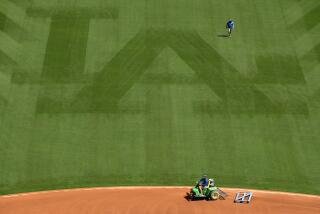They’re Making Their Pitch for Spots Behind the Plate
Major league umpire Doug Harvey once lamented that when he is right, no one remembers, and when he is wrong, no one forgets.
Such was on the minds of about 40 women and men assembled on a spring morning a few days ago at Rancho Cienega Recreation Center. They weren’t there in preparation for the start of big league baseball games today, but their decisions will affect players with every bit as much pride at stake.
On weekdays, they make a living as teachers, truckers, lawyers, plumbers. At night and on weekends, they get a hard-earned $16 to $35 for umpiring the seven-inning games of about 2,000 softball and baseball teams in the amateur leagues of the Los Angeles City Recreation and Parks Department.
And after four classroom sessions and four additional sessions in the field, the umpire candidates were on hand for their final exam--taking turns making real calls in a couple of practice games being played mostly for their benefit.
“You’ll see things in these leagues that you won’t see anywhere else,” shouted Jim Gilbert, municipal sports supervisor.
“And I’m the one who gets the phone calls that ‘the ump cost us the game.’ Then I ask what the final score was. And I hear the caller say, ’31 to 1.’ ”
“Remember, you yell ‘foul,’ not ‘foul ball!’ ” Eric Harvey barked to his attentive troops, not unlike a drill sergeant. “You don’t want the batter to think you have called the pitch a ball.”
Harvey, along with Richard Hilson, had taken the group this far, going over the rules, rehearsing the hand calls, and now it was time to put up or shut up.
John Varnell of Alhambra is 73, a retired painter for Southern Pacific Railway, and has been doing this sort of umpiring for 35 years. But like all the others taking the final exam, he was out there as he is every year, in his light blue shirt, black trousers and cap, preparing to make the calls for a few plays in a slow-pitch softball game.
“I like being out in the open air,” he said.
Better Than Watching TV
Shirley Cole, 29, an elementary school teaching assistant from Los Angeles, had different reasons: “I played softball. I can use the extra money. And umpiring is better than just sitting at home and watching TV.”
Wilma Smith, 40, a county worker, will be in her rookie year in blue, as will 15 others who were at the gathering.
“No matter what, I think the important thing is that you have to be in charge,” she said.
The color she wore will become familiar to her, since “blue” is the common form for addressing umpires in city softball--as in, “Hey, blue, let’s get the game going.”
The teams (about 15 to a roster, a total of about 30,000 players) pay $178 for the spring-summer season, which begins this month and continues through August. Additionally, each team splits the fee for the official, and each must provide a new game ball.
Competition is in four classes: A for advanced, B for intermediate, C for beginners and (new this year) D for those who have never played organized softball. The season-end prizes are trophies.
“We even have a free agent list,” John Pierce said by phone from the San Fernando Valley, where he is senior municipal sports director for the parks department. “They are people who want to play, but don’t have a team. They sign up, and their names are made available to the managers. Some team, say, may be in good shape except for needing a second baseman.”
The slow-pitch teams (which have 10 players on the field) include co-ed outfits, which must each have five women and five men and alternate them in the batting order.
No organ music, no waves building in the stands, no instant replays on a huge TV--but any victory is just as sweet as if it happened in Dodger Stadium.
325 Umps in Action
As for the umpires, 325 of them will be in action. Fast-pitch softball and baseball have the luxury of two officials, but in the slow-pitch games, it is one for all--for all players and for all calls.
“You have to be ready for anything,” said James Fennell, 52, a mail carrier from Los Angeles. “Maybe it’s two outs with runners on, and a ground ball should mean an obvious inning-ending throw to first. You start looking that way, only to realize that the throw is being made to third.”
Jim Segawa, 53, an electrical engineer from Torrance, recalled the time he got beaned because a throw should have been made to nail a runner trying to score, but for some unexplained reason it went to second.
All part of the territory, and the reason the 40 had shown up, even if it meant having to hear Harvey--after detecting the sound of somebody’s keys jangling--erupt:
“Don’t be out there running around with ding-a-ding!”
As the two mock games progressed, instructors Hilson and Harvey took pains to stop them at times and point out that a play at the plate should be called while the ump is standing in foul territory on the third base side, or that as soon as a ball is hit to the outfield the ump should head toward that direction.
Eric Harvey even gave a demonstration of brushing off home plate, the most crucial spring cleaning of all.
More to Read
Go beyond the scoreboard
Get the latest on L.A.'s teams in the daily Sports Report newsletter.
You may occasionally receive promotional content from the Los Angeles Times.










